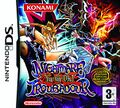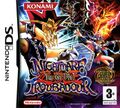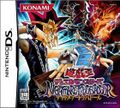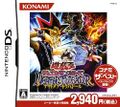Difference between revisions of "Yu-Gi-Oh! Nightmare Troubadour"
(→Gallery: image added) |
|||
| Line 135: | Line 135: | ||
==Gallery== | ==Gallery== | ||
<gallery> | <gallery> | ||
| − | NTR-VideoGameEN.jpg|North American English cover | + | NTR-VideoGameEN.jpg | North American English cover |
| − | NTR-VideoGameEU.jpg|European English cover | + | NTR-VideoGameEU.jpg | European English cover |
| − | NTR-VideoGameFR.jpg|French cover | + | NTR-VideoGameFR.jpg | French cover |
| − | NTR-VideoGameJP.jpg|Japanese cover | + | NTR-VideoGameJP.jpg | Japanese cover |
| − | NTR-VideoGameJP-KonamiTheBest.jpg|Japanese cover (Konami the Best edition) | + | NTR-VideoGameJP-KonamiTheBest.jpg | Japanese cover (Konami the Best edition) |
| + | NTR-Poster-EN.png | English promotional poster | ||
</gallery> | </gallery> | ||
Revision as of 19:13, 4 November 2019
| Yu-Gi-Oh! Nightmare Troubadour | |
|---|---|
| Yu-Gi-Oh! Nightmare Troubadour | |
| English | Yu-Gi-Oh! Nightmare Troubadour |
| Japanese translated | Yu-Gi-Oh! Duel Monsters Nightmare Troubadour |
| Developer(s) | Konami |
| Publisher(s) | Konami |
| Platform(s) | Nintendo DS |
| Release date(s) | |
| Genre(s) | Mild Fantasy Violence |
| Ratings | E |
Yu-Gi-Oh! Nightmare Troubadour is the first Yu-Gi-Oh! video game for the Nintendo DS.
Contents
New features
The Path of victory is in the cards, Search for duelists by touching the map - they are ready to face your challenge, Summon powerful 3D monsters from over 1000 cards including some of the latest cards. Duel and Trade cards wirelessly with your friends.
Unlike the previous Yu-Gi-Oh! Gameboy Advance games, it contains:
- Utilization of the DS's touch screen to make faster and easier decisions, while still able to use the buttons.
- The top screen shows a 3-D game board view of the duel including battle between monsters and animations of each Monster Card when they're on the field.
- While in the Overworld, the bottom screen shows a map to freely navigate to different areas and find duelists.
Gameplay
You roleplay as a novice duelist participating in a local tournament featuring characters from the Yu-Gi-Oh! second series anime. The storyline features elements from the Duelist Kingdom and Battle City arcs as well as the anime-only Virtual World arc.
During nighttime, the player can be intercerpted by evil duelists who will force him into Shadow Games. Any result that is not the player's victory results in a Game Over.
Special 3D Summoning
The following monsters being summoned results in a special 3D summoning animation.
- Dark Magician
- Blue-Eyes White Dragon
- Red-Eyes B. Dragon
- Slifer the Sky Dragon
- The Winged Dragon of Ra
- Obelisk the Tormentor
- Lava Golem
- Blue-Eyes Ultimate Dragon
- Red-Eyes Black Metal Dragon
- Zoa
- Curse of Dragon
- Insect Queen
- La Jinn the Mystical Genie of the Lamp
- Baby Dragon
- Alligator's Sword Dragon
- The Legendary Fisherman
- The Masked Beast
- Relinquished
- Obnoxious Celtic Guard
- Cyber-Tech Alligator
- Dark Magician Girl
- Toon Dark Magician Girl
- Summoned Skull
- Barrel Dragon
- Vorse Raider
- Dark Necrofear
- Revival Jam
- Viser Des
- Magician's Valkyria
- Cyber Harpie Lady
- Gilford the Lightning
- Jinzo
- Mystical Beast Serket
- Skull Archfiend of Lightning
- Dark Paladin
- Shinato, King of a Higher Plane
- Exodia Necross
- Silent Magician LV8
Characters
The game features characters from season 1 to 3 of the anime.
- Yami Yugi
- Yugi Muto
- Joey Wheeler
- Seto Kaiba
- Mokuba Kaiba
- Yami Bakura
- Bakura Ryou
- Tea Gardner
- Mai Valentine
- Serenity Wheeler
- Rebecca Hawkins
- Solomon Muto
- Bonz
- Mako Tsunami
- Espa Roba
- Rex Raptor
- Weevil Underwood
- PaniK
- Dox
- Para
- Maximillion Pegasus
- Bandit Keith
- Gansley
- Crump
- Johnson
- Nezbitt
- Leichter
- Noah Kaiba
- Gozaburo Kaiba
- Rare Hunter
- Strings
- Arkana
- Lumis
- Umbra
- Odion
- Ishizu Ishtar
- Marik Ishtar
- Yami Marik
- Roland
Glitches
- After defeating Odion for the first time, Pegasus no longer appears as an opponent in the American version of the game. This makes it impossible for the player to trade for his cards and get his Deck Recipe afterward, so players who wish to fully complete the game must do both of the above before defeating Odion, as trading with Pegasus is the only way the player can acquire "Imperial Order".
- In the American version of the game, "Crush Card Virus" is instead named "Deck Destruction Virus" and it shares its written lore with that card. The card still resolves with the effect "Crush Card Virus" had at the time.
- Due to following outdated rulings for both cards, using "Gravekeeper's Servant" alongside "Banisher of the Light" does not stop players from declaring attacks.
- The AI never activates "Solomon's Lawbook" unless the player controls a card with an effect that applies during the Standby Phase, mistakenly believing "Solomon's Lawbook" skips both players' Standby Phases instead of only their own.
- Due to the game using the duel interface to show the player the last duel of two Matches (Joey Wheeler versus Yami Bakura, Yami Yugi versus Seto Kaiba), it adds the results of those duels to the player's own duel record against Yami Bakura (loss) and Seto Kaiba (victory).
Trivia
- Tristan Taylor and Duke Devlin do not appear in this game even though Yugi Muto, Joey Wheeler, Serenity Wheeler, and Tea Gardner do.
- The Japanese version of this game uses many of the censored TCG card artworks instead of the Japanese ones.
- Conversely, cards such as "Widespread Ruin" and "Book of Secret Arts" uses their original Japanese artwork instead.
Promotional cards
The game also introduces 3 new Spellcaster support cards, including the Silent Magician archetype. The Japanese game guide also introduces a support card for the same themes.
Gallery
- NTR-VideoGameEN.jpg
North American English cover




